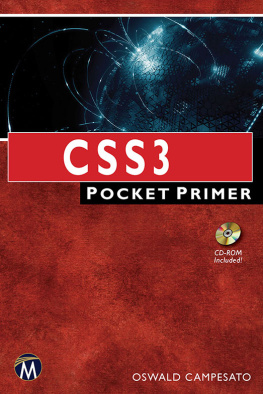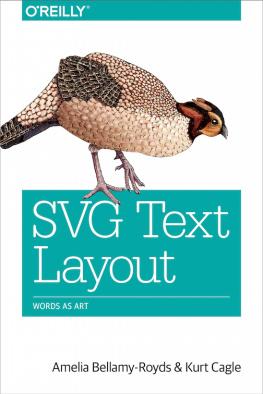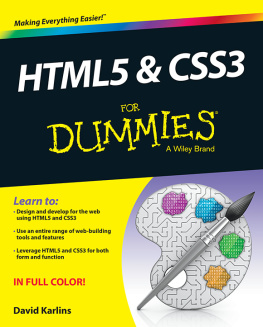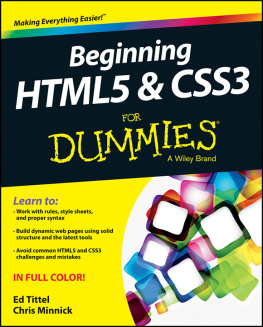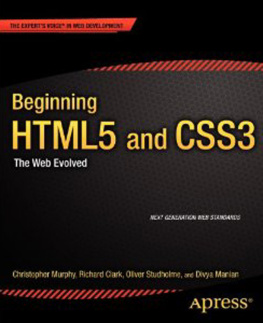Amelia Bellamy-Royds - Using SVG with CSS3 and HTML5
Here you can read online Amelia Bellamy-Royds - Using SVG with CSS3 and HTML5 full text of the book (entire story) in english for free. Download pdf and epub, get meaning, cover and reviews about this ebook. year: 2017, publisher: OReilly Media, Inc., genre: Computer. Description of the work, (preface) as well as reviews are available. Best literature library LitArk.com created for fans of good reading and offers a wide selection of genres:
Romance novel
Science fiction
Adventure
Detective
Science
History
Home and family
Prose
Art
Politics
Computer
Non-fiction
Religion
Business
Children
Humor
Choose a favorite category and find really read worthwhile books. Enjoy immersion in the world of imagination, feel the emotions of the characters or learn something new for yourself, make an fascinating discovery.
- Book:Using SVG with CSS3 and HTML5
- Author:
- Publisher:OReilly Media, Inc.
- Genre:
- Year:2017
- Rating:5 / 5
- Favourites:Add to favourites
- Your mark:
- 100
- 1
- 2
- 3
- 4
- 5
Using SVG with CSS3 and HTML5: summary, description and annotation
We offer to read an annotation, description, summary or preface (depends on what the author of the book "Using SVG with CSS3 and HTML5" wrote himself). If you haven't found the necessary information about the book — write in the comments, we will try to find it.
Using SVG with CSS3 and HTML5 — read online for free the complete book (whole text) full work
Below is the text of the book, divided by pages. System saving the place of the last page read, allows you to conveniently read the book "Using SVG with CSS3 and HTML5" online for free, without having to search again every time where you left off. Put a bookmark, and you can go to the page where you finished reading at any time.
Font size:
Interval:
Bookmark:
by Amelia Bellamy-Royds , Kurt Cagle , and Dudley Storey
Copyright 2018 Amelia Bellamy-Royds, Kurt Cagle, Dudley Storey. All rights reserved.
Printed in the United States of America.
Published by OReilly Media, Inc. , 1005 Gravenstein Highway North, Sebastopol, CA 95472.
OReilly books may be purchased for educational, business, or sales promotional use. Online editions are also available for most titles (http://oreilly.com/safari). For more information, contact our corporate/institutional sales department: 800-998-9938 or corporate@oreilly.com .
- Editor: Meg Foley
- Production Editor: Kristen Brown
- Copyeditor: Rachel Monaghan
- Proofreader: James Fraleigh
- Indexer: Amelia Bellamy-Royds
- Interior Designer: David Futato
- Cover Designer: Karen Montgomery
- Illustrator: Rebecca Demarest
- November 2017: First Edition
- 2017-10-17: First Release
- 2018-03-09: Second Release
See http://oreilly.com/catalog/errata.csp?isbn=9781491921975 for release details.
The OReilly logo is a registered trademark of OReilly Media, Inc. Using SVG with CSS3 and HTML5, the cover image, and related trade dress are trademarks of OReilly Media, Inc.
While the publisher and the authors have used good faith efforts to ensure that the information and instructions contained in this work are accurate, the publisher and the authors disclaim all responsibility for errors or omissions, including without limitation responsibility for damages resulting from the use of or reliance on this work. Use of the information and instructions contained in this work is at your own risk. If any code samples or other technology this work contains or describes is subject to open source licenses or the intellectual property rights of others, it is your responsibility to ensure that your use thereof complies with such licenses and/or rights.
978-1-491-92197-5
[LSI]
Scalable Vector Graphics (SVG to its friends) has many applications. It is used by graphic designers and by technical drafters. But this book is specifically about its use in web design and development.
Using SVG with CSS3 and HTML5 is, essentially, using SVG on the web. But more than that, its about using SVG in complex web applications. This is SVG not only as illustrations, but as graphical documents that can be integrated in HTML web pages, and styled with custom CSS. Many chapters will be useful to designers creating images for the web, but the focus is on developers who are adapting designs to add data-based graphics, dynamic styles, interaction, or animation.
This book traces its origins to 2011, when Kurt started work on a book called HTML5 Graphics with SVG and CSS3. At the time, HTML5 and CSS3 were brand new, and SVG was just starting to get decent support in web browsers.
But life, as it often does, got in the way. The book took much longer than planned to complete. And time introduced its own complications.
When Kurt handed off the manuscript to Amelia in late 2014, the state of graphics on the web had changed considerably since when hed started it. HTML had acquired competely new graphics formats (the Canvas2D API and WebGL), which were completely separate from SVG and CSS. And CSS3 was becoming a bigger and bigger topic every year, quickly outgrowing the one chapter planned for it.
So the decision was made to focus on SVG. However, this book is still all about the intersection of the three web languagesand JavaScript, too! The driving goal for the rewrite was to create a practical guide to using SVG on the web, in complex web pages, with full awareness of the need for cross-browser, multidevice support.
That turned out to be easier said than done. Its taken a few more years (and one more coauthor, Dudley) to complete this manuscript. Its also a considerably larger book than initially planned. We hope it was worth the wait.
SVG is a complex topic, but we have tried to arrange this book in a logical progression. begins with the wide view, discussing howand whyyou use SVG in web design:
The possibilities of SVG as an independent image format, in
SVG on the web, with a focus on how it interacts with other coding languages, in
How CSS can be used to style your SVG, and how SVG graphics can be used with CSS to style other documents, in
Useful software for creating and testing SVG images, as well as some sources of ready-to-use SVG for less artistically inclined web developers, in
The remainder of the book will narrow in on each of the main features of SVG one chapter at a time. concentrates on the core drawing elements in SVG, and how to control their geometry and layout:
Sizing and positioning basic shapes, in
Defining custom shapes and lines, in
Text layout, in
dives into the technical details of how SVG documents are constructed and how vector shapes are positioned:
Establishing coordinate systems and scale, in
Redefining coordinate systems when embedding graphics in web pages, in
Reusing content and embedding images, in
Transforming coordinate systems to reposition and distort graphics, in
focuses more on the graphical side of the language:
Filling the area of shapes and text, including gradients and patterns, in
Drawing outlines around shapes and text, in
Adding line markers (repeated symbols on the ends or corners of custom shapes), in
Clipping and masking of graphics, in
Filter effects and blend modes, in
looks at how the basic structure of SVG images can be enhanced to create complete web applications, focusing on three main areas:
Accessibility and metadata, in
Interactive SVG, links, and event handling, in
Animation using CSS, XML, or JavaScript, in
Once you have all the pieces in place, returns to the big picture, discussing best practices for working with SVG.
This book focuses on using SVG in web pages. It assumes that you, the reader, are already familiar with creating web pages using HTML, CSS, and a little bit of JavaScript. When the examples use relatively new features of CSS3 and HTML5, well explain them briefly, but well assume you know a
- , and a
font-familyfrom afont-style.Youll get the most out of the book by working through the code samples as you go. It will help if you have a good code editor that recognizes SVG syntax, and if you know how to use the developer tools in your web browser to inspect the document structure and styles that create the visible result.
Whether youre casually flipping through the book, or reading it meticulously cover-to-cover, you can get more from it by understanding the following little extras used to provide additional information .
The following typographical conventions are used in this book:
BoldIndicates new terms or concepts.
ItalicIndicates URLs, email addresses, filenames, and file extensions, or simply emphasizes that a word is really important.
Constant widthUsed for code listings, as well as within paragraphs to refer to code elements such as elements, attributes, keywords, and function names.
Font size:
Interval:
Bookmark:
Similar books «Using SVG with CSS3 and HTML5»
Look at similar books to Using SVG with CSS3 and HTML5. We have selected literature similar in name and meaning in the hope of providing readers with more options to find new, interesting, not yet read works.
Discussion, reviews of the book Using SVG with CSS3 and HTML5 and just readers' own opinions. Leave your comments, write what you think about the work, its meaning or the main characters. Specify what exactly you liked and what you didn't like, and why you think so.


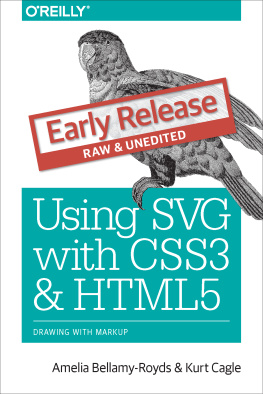
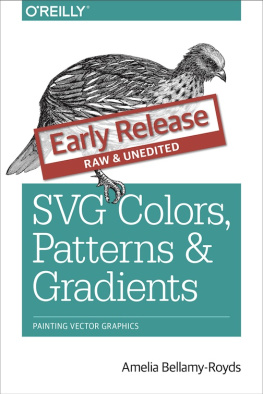
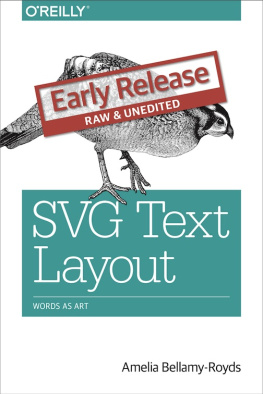


![J. David Eisenberg and Amelia Bellamy-Royds - SVG essentials: [producing scalable vector graphics with XML]](/uploads/posts/book/193501/thumbs/j-david-eisenberg-and-amelia-bellamy-royds-svg.jpg)
